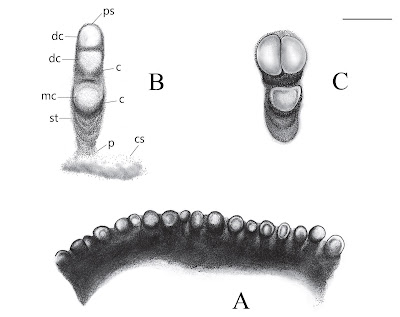Cyanobacteria are
filament-forming photosynthetic Bacteria which often form dense mats by
extruding polysaccharide films, which bind the individual filamentous colonies
together as well as attaching them to surfaces. These mats are among the first
biological traces found in the geological record, with stromatolites (deposits
in which thin layers of microbial mat alternate with other sedimentary deposits
such as limestone or sands) being found in some of oldest sedimentary
formations on Earth. Modern Cyanobacteria are found in all modern ecosystems
where there is light, including desert sands and the surfaces of glaciers, but
their full diversity is poorly understood, though the group is no longer
thought to be monophyletic (it is no longer thought that all members of the
group are descended from a single common ancestor) and there are likely to be
many undiscovered species living in poorly explored environments.
In a paper published in the
journal Phytotaxa on 24 July 2015, Michelle Gold-Morgan, Laura González-Resendiz, Hilda León-Tejera and Gustavo Montejano of the Departamento de Biología Comparada at the Universidad Nacional Autónoma de México describe a
new species of Cyanobacteria from rocky shores on the coast of Oaxaca State,
Mexico.
The new species is named Nisada stipitata, where ‘Nisada’ means ‘marine’ in the indigenous
Zapotec language spoken in parts of Oaxaca State and ‘stipitata’ meand ‘stipulate’ (having dots) in Latin. The species is
described from colonies found living on granitic rocks on the coast of Oaxaca
near San Agustín in Huatulco, where the Sierra Madre del Sur
mountains meat the sea in a series of rocky bays and cliffs. Nisada stipitata forms colonies up to 5
mm thick, with each colony consisting of a biofilm to which numerous coccoid
(spherical) cells are attached by short stipes (stems).
Morphology of Nisada stipitata.
(A) Macroscopic view of partially covered rock (black portion). (B) Macroscopic
view of strip of biofilm on rock. (C) Pseudofilament apices in fluorescent
microscopy. (D) Edge of biofilm with pseudofilaments in a row. (E) Apices of
morph 2 before cell division (single arrow) and after division but before
separation (double arrow). Gold-Morgan et
al. (2015).
The coccoid cells show distinct
polarity, which is to say that they have distinct ends, despite being
spherical. The stipes of the cells form distinct rows in on the biofilm, with
each stipe supporting one-to-three cells; this is connected to the way in which
the cells divide, either in or at 90˚ to the plane of the stipe-row, with each
parent cell apparently splitting into two daughter cells, one of which then
itself splits in two, resulting in three cells on the stipe. Further divisions
after this are not seen, and numerous stipes were found without cells,
suggesting a distributive phase (cells leaving the stipe and either settling in
the biofilm or forming new colonies).
Line drawings of Nisada stipitata.
(A) Edge of biofilm with pseudofilaments in a row. (B) Complete pseudofilament
of morph 1. (C) Complete pseudofilament of morph 2. Ps, pseudofilament sheath;
dc, daughter cell; c, cup; mc, mother cell; st, stipe; p, pad; cs, colonial
sheath. Scale bars: (A) 8 μm, (B, C) 6 μm. Gold-Morgan et al. (2015).
Insufficient material of Nisada stipitata was recovered to allow
a DNA comparison to other Cyanobacteria (which is generally considered the best
way to compare and classify any Bacterium), and it did not prove possible to
cultivate the species in the lab. However reproductive strategies and in
particular splitting plains are considered significant in the classification of
these organisms, and the pattern of splitting seen in Nisada stipitata is sufficiently unique that Gold-Morgan et al. are confident in their diagnosis
of the colonies as a new species.
(Top) Line drawing of life cycle of morph 1. (Bottom) Line drawing of
life cycle of morph 2. . Gold-Morgan et
al. (2015).
See also…
Water quality is a major issue in South Africa, where efforts to expand clean water supplies to the whole population in the post-Apartheid era have faced severe challenges due to a limited supply of potable...
In the nineteenth century the origin of life seemed an intractable problem for palaeontologists, with large complex animal fossils appearing in the Cambrian explosion, but scientists having access to neither examples of earlier fossils nor the means with which to examine them. However from the early twentieth...
Cyanobacteria are filament-forming photosynthetic Bacteria found across the globe and with a fossil record dating back over 3.5 billion years. They are thought to have been the first organisms on Earth to obtain carbon through photosynthesis, and it is also thought that the...
Follow Sciency Thoughts on
Facebook.






